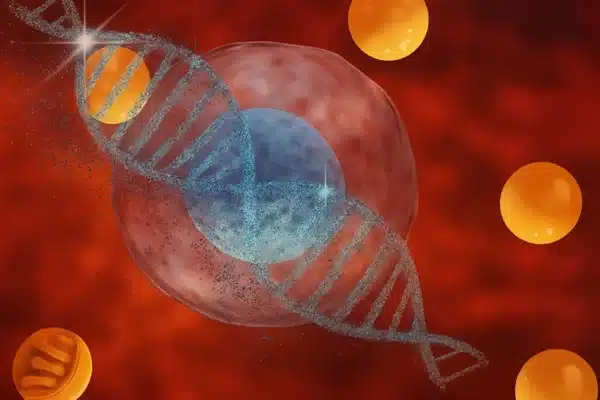Oxidative stress and cellular inflammation are interrelated processes that impact the balance of the organism at the cellular level.
Although both are essential defense mechanisms, their dysregulation can generate a damaging cycle that affects multiple systems. This article explores how these biological responses are connected and discusses how homeostatic optimization and epigenetic modulators may offer innovative solutions to address these challenges.
What is oxidative stress?
Oxidative stress occurs when there is an excess of reactive oxygen species (ROS) relative to the body’s ability to neutralize them with antioxidants. This imbalance creates an intracellular environment that promotes structural damage to proteins, lipids, and DNA.
Essential functions of ROS
ROS plays a fundamental role in cell signaling and defense against pathogenic microorganisms. However, at elevated levels, their effect becomes detrimental, leading to:
– Mitochondrial damage, compromising cellular energy production.
– Cell membrane dysfunction, affecting intracellular communication.
– Alterations in DNA, which can affect gene expression.
Main triggers of oxidative stress
Internal factors:
– Metabolic processes, such as oxidative phosphorylation.
– Activation of immune systems in response to infections.
2. External factors:
– Ultraviolet radiation and exposure to heavy metals.
– Diets rich in saturated fats or poor in natural antioxidants.
– Environmental pollution and tobacco.
What is cellular inflammation?
Cellular inflammation is a biological response that seeks to repair damaged tissues or combat invading entities. While it is normal from time to time, when it becomes chronic it can trigger profound alterations in the cellular microenvironment.
Phases of inflammation
Acute inflammation: Rapid and localized response, with increased blood flow and migration of immune cells to the affected area.
Chronic inflammation: characterized by prolonged activation of inflammatory mediators, even in the absence of an overt stimulus.
Key inflammatory markers
– Proinflammatory cytokines: such as TNF-α and IL-6, which perpetuate inflammation.
– C-reactive protein (CRP): Indicator of persistent systemic inflammation.
The link between oxidative stress and cellular inflammation.
Oxidative stress and cellular inflammation form a feedback loop. ROS generated during oxidative stress activates inflammatory pathways, while inflammatory processes amplify ROS production, creating a detrimental cycle.
Molecular mechanisms involved
NF-κB activation
The transcription factor NF-κB regulates the expression of inflammation-related genes. ROS act as signals that activate this pathway, intensifying the production of inflammatory cytokines.
Nitric oxide generation
Under conditions of oxidative stress, excess nitric oxide is generated, a molecule that contributes to oxidative damage and promotes chronic inflammation.
Impact of the oxidative stress-inflammation cycle
This cycle affects various processes, such as:
– Alteration of tissue repair.
– Promotion of a proinflammatory cellular environment.
– Increased structural damage in key cellular organelles.
Epigenetic optimization: an innovative approach
Epigenetic optimization: an innovative approach
Epigenetic optimization offers an advanced and personalized perspective to influence both oxidative stress and cellular inflammation. This approach uses the understanding of cellular mechanisms to personalize intervention strategies through precision medicine.
What are epigenetic modulators?
Epigenetic modulators are factors that influence gene expression without altering the DNA sequence. They include:
– DNA methylation changes, which can regulate genes associated with inflammation.
– Histone modifications, which affect access to genetic information.
Practical example
A diet rich in antioxidant compounds, such as polyphenols, can act as an epigenetic modulator. These compounds influence the activity of inflammation-related enzymes, such as histone deacetylases (HDACs).
Benefits of epigenetic optimization in this context
1. Reduction of cellular inflammation: by regulating the activity of proinflammatory genes.
2. Control of oxidative stress: Enhancing endogenous antioxidant systems such as superoxide dismutase (SOD).
3. Promotion of a balanced cellular environment: Enhancing the adaptive responsiveness of cells.
Practical strategies to interrupt the damaging cycle
Lifestyle changes
1. Personalized nutrition
– A diet rich in natural antioxidants, such as vitamins C and E, can help neutralize ROS.
– Consumption of omega-3 fatty acids modulates inflammation at the epigenetic level.
2. Moderate physical activity
– Regular exercise stimulates the production of endogenous antioxidants and improves cellular capacity to handle oxidative stress.
Controlled environment
Reducing exposure to environmental pollutants and other ROS triggers can significantly reduce oxidative stress and chronic inflammation.
Long-term implications of proper management
Managing oxidative stress and cellular inflammation is key to preventing functional impairment at the cellular level. The integration of strategies based on epigenetic optimization allows these processes to be addressed in a personalized and effective manner.
Benefits at the cellular level
– Enhanced regeneration: Damaged cells recover their more quickly
– Enhanced cellular resilience: Adaptive capacities to external stimuli are reinforced.
– Sustained functional balance: The negative effects of the oxidative stress-inflammation cycle are minimized.
Conclusion:
Oxidative stress and cellular inflammation form a complex relationship that require comprehensive and advanced approaches to its management. Epigenetic optimization, through epigenetic modulators and personalized strategies, presents itself as an innovative solution to interrupt this detrimental cycle. Adopting this approach not only promotes a balanced cellular environment, but also lays the foundation for sustained and adaptive wellness.

